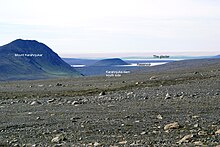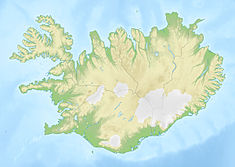Kárahnjúkar Hydropower Plant
| Kárahnjúkastífla Dam Kárahnjúkar Hydropower Plant |
|
|---|---|

Kárahnjúkastífla Dam, looking south.
|
|
|
Location of Kárahnjúkastífla Dam
Kárahnjúkar Hydropower Plant in Iceland |
|
| Country | Iceland |
| Coordinates | 64°56′N 15°48′W / 64.933°N 15.800°WCoordinates: 64°56′N 15°48′W / 64.933°N 15.800°W |
| Status | Operational |
| Opening date | 2009 |
| Dam and spillways | |
| Type of dam | Embankment, concrete-face rock-fill dams |
| Impounds | Jökulsá á Dal River Jökulsá í Fljótsdal River |
| Height | 193 m (633 ft) |
| Length | 730 m (2,400 ft) |
| Dam volume | 8.5×106 m3 (300×106 cu ft) |
| Spillways | 1 |
| Spillway type | Tunnel |
| Reservoir | |
| Creates | Hálslón Reservoir |
| Total capacity | 2.1 km3 (1,700,000 acre·ft) |
| Max. length | 25 km (16 mi) |
| Power station | |
| Operator(s) | Landsvirkjun |
| Turbines | 6 x 115 MW (154,000 hp) Francis-type |
| Installed capacity | 690 MW |
| Annual generation | 4,600 GWh |
Kárahnjúkar Hydropower Plant (Icelandic Kárahnjúkavirkjun) is a hydroelectric power plant in Fljótsdalshérað municipality in eastern Iceland designed to produce 4,600 gigawatt-hours (17,000 TJ) annually for Alcoa's Fjardaál aluminum smelter 75 kilometres (47 mi) to the east in Reyðarfjörður. With the installed capacity of 690 megawatts (930,000 hp), the plant is the largest hydroelectric power plant in Iceland. The project, named after nearby Mount Kárahnjúkur, involves damming the Jökulsá á Dal river and the Jökulsá í Fljótsdal river with five dams, creating three reservoirs. Water from the reservoirs is then diverted through 73 kilometres (45 mi) of underground water tunnels and down a 420-metre (1,380 ft) vertical towards a single underground power station. The smelter became fully operational in 2008 and the hydro-power project was completed in 2009.
The Kárahnjúkastífla Dam is the centerpiece of the five dams and the largest of its type in Europe, standing 193 metres (633 ft) tall with a length of 730 metres (2,400 ft) and comprising 8.5 million cubic metres (300×106 cu ft) of material.
The project has been criticised for its environmental impact and its use of foreign workers.
The hydroelectricity project harnesses the Jökulsá á Dal and Jökulsá í Fljótsdal Rivers by creating three reservoirs with five concrete-face rock-filled embankment dams; three on the Jökulsá á Dal River and two on the Jökulsá í Fljótsdal River. After being used in the Fljótsdalur Power Station, all water used in electricity production is discharged into the Jökulsá í Fljótsdal River.
Three dams on the Jökulsá á Dal River; the Kárahnjúkastífla Dam, the Desjarárstífla Dam and the Sauðárdalsstífla Dam create the Hálslón Reservoir. At 193 metres (633 ft) tall and 730 metres (2,400 ft) long, the Kárahnjúkastífla Dam is the largest dam in the project and the largest of its type in Europe as well. The 60-metre (200 ft) tall and 1,000-metre (3,300 ft) long Desjarárstífla Dam and the 25-metre (82 ft) tall and 1,100-metre (3,600 ft) long Sauðárdalsstífla Dam are saddle or auxiliary dams that maintain the desired height of the Hálslón reservoir. Water from the 25-kilometre (16 mi) long, 2.1-cubic-kilometre (1,700,000 acre·ft) capacity Hálslón Reservoir (about the size of Manhattan island in New York) is diverted down a 39.7-kilometre (24.7 mi) long, 7.2–7.6-metre (24–25 ft) diameter headrace tunnel towards the Fljótsdalur Power Station.
...
Wikipedia

